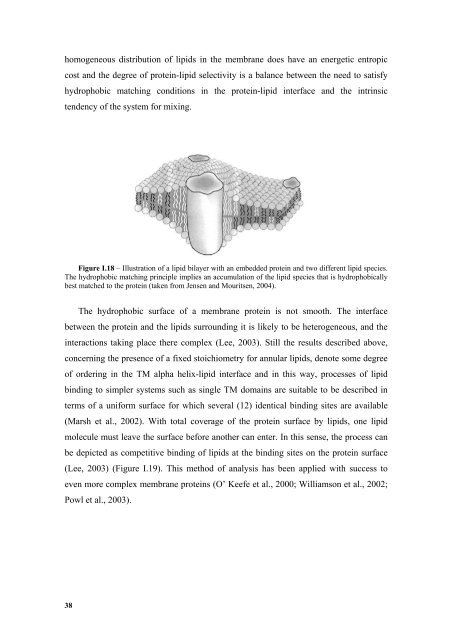Biophysical studies of membrane proteins/peptides. Interaction with ...
Biophysical studies of membrane proteins/peptides. Interaction with ...
Biophysical studies of membrane proteins/peptides. Interaction with ...
You also want an ePaper? Increase the reach of your titles
YUMPU automatically turns print PDFs into web optimized ePapers that Google loves.
homogeneous distribution <strong>of</strong> lipids in the <strong>membrane</strong> does have an energetic entropic<br />
cost and the degree <strong>of</strong> protein-lipid selectivity is a balance between the need to satisfy<br />
hydrophobic matching conditions in the protein-lipid interface and the intrinsic<br />
tendency <strong>of</strong> the system for mixing.<br />
Figure I.18 – Illustration <strong>of</strong> a lipid bilayer <strong>with</strong> an embedded protein and two different lipid species.<br />
The hydrophobic matching principle implies an accumulation <strong>of</strong> the lipid species that is hydrophobically<br />
best matched to the protein (taken from Jensen and Mouritsen, 2004).<br />
The hydrophobic surface <strong>of</strong> a <strong>membrane</strong> protein is not smooth. The interface<br />
between the protein and the lipids surrounding it is likely to be heterogeneous, and the<br />
interactions taking place there complex (Lee, 2003). Still the results described above,<br />
concerning the presence <strong>of</strong> a fixed stoichiometry for annular lipids, denote some degree<br />
<strong>of</strong> ordering in the TM alpha helix-lipid interface and in this way, processes <strong>of</strong> lipid<br />
binding to simpler systems such as single TM domains are suitable to be described in<br />
terms <strong>of</strong> a uniform surface for which several (12) identical binding sites are available<br />
(Marsh et al., 2002). With total coverage <strong>of</strong> the protein surface by lipids, one lipid<br />
molecule must leave the surface before another can enter. In this sense, the process can<br />
be depicted as competitive binding <strong>of</strong> lipids at the binding sites on the protein surface<br />
(Lee, 2003) (Figure I.19). This method <strong>of</strong> analysis has been applied <strong>with</strong> success to<br />
even more complex <strong>membrane</strong> <strong>proteins</strong> (O’ Keefe et al., 2000; Williamson et al., 2002;<br />
Powl et al., 2003).<br />
38















